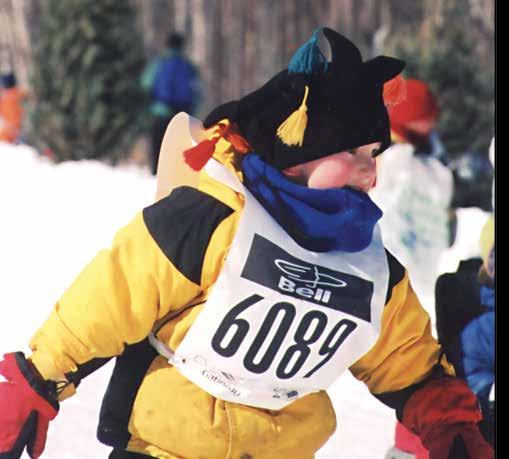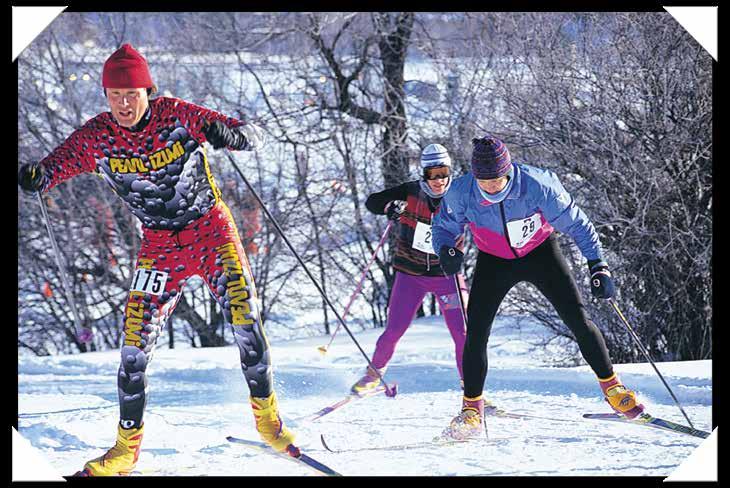
5 minute read
NORDIC SKIING
Ski your first Keskinada Loppet Some tips to get you started
By Claude Laramée
Advertisement
CONVINCED that loppets are populated only by elite athletes who treat cross-country skiing as a new religion?
Maybe you’ve seen the TV ads, or your friends have talked about it, or perhaps you’ve been close enough to cheer on the frost-caked skiers crossing the finish line. But, the notion of doing it yourself sends a wintry shudder down your spine. Skiing 25 or 50 kilometres through the far reaches of Gatineau Park has not been your idea of a good time.
This, too, can change.
For many people, the Keskinada Loppet is their main winter objective. Every year, skiers start to get ready for the mid-February event as summer begins to wane. This gala event held in the National Capital Region is geared to winter enthusiasts of all ages and skill levels.
The Keskinada Loppet is Canada’s largest cross-country ski event. The 25 th edition held last February attracted 3,428 participants, including 563 skiers visiting Canada
from 22 countries. The Keskinada Loppet is more than a race—it is an event.
The organizers go to great lengths to introduce activities for all ages and abilities. The signature 50-km Freestyle event takes place on Sunday, February 15th. There are also a 25-km and a 10-km Free Style event on the same day. The Classic Style events on Saturday include 5-km, 25-km, and 50-km races. The youngsters’ event—MiniKeski—provides the skiers of tomorrow with a 2-km course. Volunteers dressed according to the annual theme will entertain them along the course.
The great thing about all these events is that skiers are encouraged to travel at their own speed for each event. For example, skiers in the 50-km Freestyle event will leave the start area at the same time as about 1,000 other participants. Skiers are seeded into waves with the faster ones leaving first.
The start of the 50-km Freestyle is one of the most exciting moments of the ski season. Participants will ski for two to six hours, depending upon their ability and stamina. An entrant who skis once a week for about three hours can expect to



be on the course for around five hours. The elite skiers will be back at the finish line in just over two hours.
All along the course, you will experience what the Keski is all about. After a few kilometres, you’ll be skiing with people who share a similar level of skill. They might be strangers at first, but a sense of camaraderie quickly evolves.
After initial words of encouragement, you discuss where you’re from, where you ski, and how many times you have done the Keskinada. At approximately the 10-km point, you reach the first feeding station. These stations are run by 20 to 25 volunteers who make sure you get something to drink and eat. They’ll also check to see if you’re feeling well enough to keep going.
All along the 50-km course, as in all the other Keskinada distances, skiers enjoy breathtaking scenery and perfectly groomed trails. The knowledge and effort of 450 volunteers make the events run smoothly year after year. Organizers do everything possible to make the skiers’ experience memorable so they will join again.
As you begin to tire along the 50-km course, you may be tempted to ask yourself, “What am I doing here?” You will take comfort in noticing that your newfound skiing partners also seem a little tired. You may then recognize that little voice from inside saying, “I’ve started this thing and I’ll finish it.” You forge on. A few minutes later, you reach a feeding station, have something to drink, eat a banana or an energy bar and get back in the tracks even more determined then ever.
Nearing the end of the Keskinada course, you pass a marker on the Gatineau Parkway near trail #26 that tells you there is just one kilometre left to go! You’re almost there. On trail #26 you go up and down a few rolling hills and finally, down the last long hill onto a 100-metre flat stretch. You see the crowd of spectators, the finish area and the big banner rippling in the wind at the finish line.
You feel that incredible sense of accomplishment that comes with going the distance. Crossing the finish line is always special for both the experienced skier and the first timer. And it’s not over—the finish area features the last feeding station on the course. You’ll have a chance to chat with new acquaintances and proceed into the main building for the post-race meal and a last visit to the ski show.
The Keskinada Loppet has been designed for maximum pa rticipation across all skill levels using the classic or freestyle technique. Skiers need only reserve the weekend on their calendar and register for the race they wish to enter. The classic events take place on Saturday, February 14 and freestyle events will be on Sunday, February 15.
preparation tips
Here are a few suggestions that will prepare you for the long-range courses:
First of all, make sure that your equipment is in good condition. If you are buying new skis or boots, the latest or the best equipment is not absolutely necessary. Remember that you will glide better on medium-priced skis with the correct camber than on a high-end pair that isn’t the right fit for you. You should wear several layers of clothing that draw moisture away from your body. You will appreciate the option to add or subtract a layer once you are on the course.
Secondly, start now to get into shape for the Keskinada— February is not that far away. A simple point of departure is to start taking long walks. Initially, try to walk for an hour or so in your neighbourhood. Later on, go for longer periods on the Gatineau Park trails. Long climbs on the trails leading up to Ridge Road or Trail 1 are an excellent way to train. The more time

you spend preparing for the event, the easier it will be to attain your goal.
For event and registration information, consult the web site at www.keskinada.com or phone (819) 595-0114. —Claude Laramée is the President of the Keskinada Loppet.









